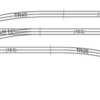I have Greenberg's wiring book but it does not help me with this one. Given the attached photo which is a portion of my upcoming layout, I need to know where to put the power drops. Normally I would just put a feed every 6 or 10 feet. The turnouts will all be manual throws. I am not sure where I can locate the power drops or where they "must be" given the turnouts. I have heard things like "you have to power all 3 legs of the turnout but am not totally sure what that means. Perhaps it just means there has to be power on each leg coming off the turnout?
I googled this and could find nothing.





